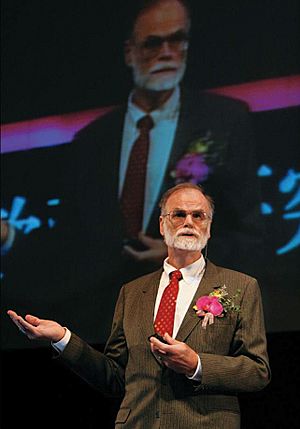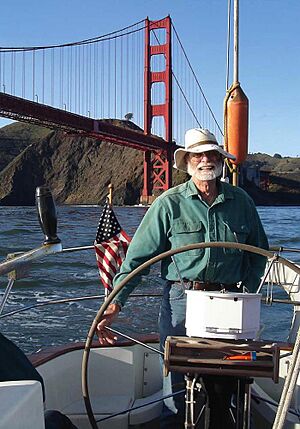Jim Gray (computer scientist) facts for kids
Quick facts for kids
Jim Gray
|
|
|---|---|

Gray in 2006
|
|
| Born |
James Nicholas Gray
January 12, 1944 San Francisco, California
|
| Disappeared | January 28, 2007 (aged 63) Waters near San Francisco |
| Status | Declared dead in absentia January 28, 2012 (aged 68) |
| Nationality | American |
| Alma mater | University of California, Berkeley (Ph.D.) |
| Occupation | Computer scientist |
| Employer | |
| Known for | Work on database and transaction processing systems |
| Spouse(s) | Loretta (divorced), Donna Carnes (widowed) |
| Children | 1 (daughter) |
| Awards | Turing Award (1998) IEEE Computer Society Charles Babbage Award (1998) |
James Nicholas Gray (1944 – 2012) was an American computer scientist. He won the Turing Award in 1998. This award is like the Nobel Prize for computer science! He was honored for his important work on databases and how computers handle many tasks at once (called transaction processing systems).
Contents
Early Life and Education
Jim Gray was born in San Francisco, California, in 1944. His family moved to Rome, Italy, where he spent his first three years. He learned to speak Italian before English! Later, his family moved back to the United States.
In 1961, Jim started college at the University of California, Berkeley. To help pay for school, he worked for a company called General Dynamics. There, he learned how to use a Monroe calculator. He earned his bachelor's degree in engineering mathematics in 1966.
After college, Jim worked at Bell Labs in New Jersey. He also studied for his master's degree at New York University. He then returned to Berkeley for his Ph.D. in programming languages. He finished his Ph.D. in 1969.
Computer Science Research
Jim Gray spent his career as a researcher and software designer. He worked at big companies like IBM, Tandem Computers, and DEC. In 1995, he joined Microsoft as a Technical Fellow. He stayed there until he disappeared in 2007.
Jim made many important contributions to database and transaction processing systems. For example, IBM System R was a project he worked on. This project led to SQL databases, which are used everywhere today. At Microsoft, he helped create TerraServer-USA and Skyserver. These projects stored huge amounts of map and sky data.
Some of his most famous achievements include:
- ACID rules: These are important rules for making sure computer transactions are reliable. They ensure data is handled correctly.
- Granular database locking: This helps many users work with a database at the same time. It prevents errors.
- Two-tier transaction commit: This is a way to make sure all parts of a computer task are finished correctly.
- The Five-minute rule: This rule helps decide how to store data efficiently.
- OLAP cube operator: This helps analyze large amounts of data, like in a data warehouse.
He also helped develop Virtual Earth, which is a mapping program. Jim was also one of the people who started the Conference on Innovative Data Systems Research.
Disappearance at Sea
Jim Gray loved sailing and owned a 40 feet (12 m) sailboat. On January 28, 2007, he went on a short solo trip. He planned to scatter his mother's ashes at the Farallon Islands near San Francisco. The weather was good, but he never returned. No one heard any distress calls from his boat.
The Coast Guard searched for four days using planes, helicopters, and boats. They found nothing. People around the world helped look for him. A satellite company, DigitalGlobe, took pictures of the area. Thousands of people, including Jim's friends and colleagues, looked at these images online for clues.
The search was stopped on February 16, 2007. An underwater search also ended without finding him. On January 28, 2012, Jim Gray was officially declared legally dead.
Microsoft's WorldWide Telescope software is dedicated to Jim Gray. In 2008, Microsoft opened a research center in Madison, Wisconsin, named after him.
Jim Gray eScience Award
Each year, Microsoft Research gives out the Jim Gray eScience Award. This award goes to a researcher who has made amazing contributions to data-intensive computing. This field is all about working with very large amounts of data. The award honors people who have done groundbreaking work in eScience.
See also
 In Spanish: Jim Gray para niños
In Spanish: Jim Gray para niños


